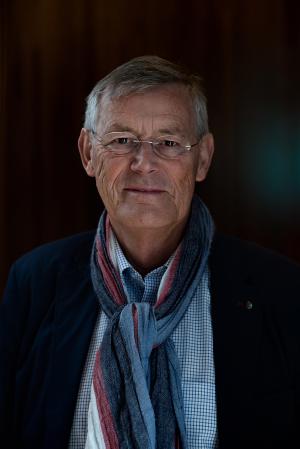Jacques Joosten and Jan Stamhuis both held key positions at DPI for a decade and a half, Jacques as Managing Director and Jan as Programme Area Coordinator. They both took their farewell of DPI at the end of 2019. In this interview they talk to us about their experience of DPI during an exciting and crucial period of its history.
|
Jacques Joosten was Managing Director of DPI from 2005 to 2019. Jacques, who holds a PhD in Physical Chemistry and Colloid Sciences from Utrecht University, was Director of Corporate Technology at DSM until 2005. Under Jacques’ leadership, DPI underwent a major transformation: from a public-private partnership to a primarily industry-funded collaboration platform. |
Jan Stamhuis was Programme Area Coordinator at DPI for 15 years, from 2004 to 2019. A polymer scientist with a PhD from Groningen University, he initially worked at Shell, where he held a variety of positions for 25 years. At DPI, he oversaw the programme areas of Polyolefins, Engineering Plastics and Rubber Technology. During the period 2013-2019, Jan was also responsible for IP and Legal Matters at DPI. |
1. What can you tell us about DPI’s early years?
Jacques: The idea of setting up an institute like DPI arose around the mid-1990s when various strategic strands in the polymer sector converged. Firstly, it was felt that the imbalance between research and education at universities had resulted in a shortage of competently trained polymer experts. Secondly, there was a rise in demand for certain competences to support the ongoing diversification process in industry. And thirdly, there was a growing need to organize industrial research more cost-efficiently. For example, companies were often working simultaneously on common themes in their respective Corporate Research programmes; it was felt that they could lower costs by conducting some research jointly. The need to cut research costs also had to do with increasing decentralisation, where newly created business groups had to compete in the international market. These developments in industry, together with the Dutch government’s desire to build a strong knowledge infrastructure in polymers, led to the initiative to establish DPI.
Jan: The DPI concept represented a unique value proposition: industrial competitors pooled resources, worked together in non-competitive areas, generated synergy and inspired one another. This was DPI’s added value as compared to the universities. However, not all companies were comfortable with the idea of joining forces with competitors. In this respect, cultural differences between countries played a major role. For example, it took a long time before American companies recognized the benefit of this kind of collaboration.
2. Were Intellectual Property Rights an issue for the companies?
Jacques: IP rights have always been somewhat of a hurdle. Here, too, cultural differences between countries were a factor. The Americans, for example – like the Chinese – don’t understand that IP ownership is not a major concern for the companies. In the DPI framework, participating companies can acquire IP through the process of ‘right of first refusal’.
Jan: Foreign companies with affiliates in the Netherlands were better able to understand the idea of working together in consortia, in other words that collaboration could be a strategic choice. Consequently, they were able to appreciate the DPI concept, including the way of handling IP rights.
3. Did the original funding structure provide a good basis for the role envisaged for DPI?
Jacques: Yes, it did. The government support in the early years was of crucial importance. Not only did it benefit the participating companies by doubling their monetary contribution, it also enabled DPI to help bolster the strong position the Netherlands already had in polymers and plastics. DPI had hoped that after the first decade, the government’s financial incentives would become an integral part of polymer research funding by NWO (the Dutch Research Council), but this did not happen.
4. The funding structure has meanwhile changed. What has this change meant in practice?
Jacques: The “Top Sectors and TKI Policy” implemented in 2014 put an end to the direct government funding for institutes like DPI. This has had a significant negative impact on both expertise and employment in the polymer sector in the Netherlands. Over the years we have seen a gradual shift towards a shorter-term, application-driven focus. Generic and exploratory research have come under pressure. Overall, the volume of polymer research in the Netherlands has shrunk, which is also impacting the academic knowledge base in polymers.
Jan: For an institute like DPI, the change in funding has also meant a change in scope for initiating projects. Given the current setup, with two-thirds of our money coming from our industrial partners, our research programmes are obviously geared more to current industry needs and there is little room for long-term, generic research.
5. Is the public-private concept better than a primarily industry-funded setup?
Jacques: That depends on what you want. For example, without public funding we would not have been able to build a strong knowledge infrastructure in the Netherlands. On the other hand, building a knowledge infrastructure is not enough; you need to maintain it, otherwise erosion sets in – as is happening now. Here again, public funding is important.
As I see it, the government has an important responsibility in stimulating innovation. But innovation is not something you do with the aim of gaining returns within, say, 5 years; it means investing in the future. Take the example of the semi-conductor industry in the US. The innovation efforts were started in the 1940s and it was only twenty years later, in the 1960s, that these efforts began to yield results. The same was the case with innovation in IT.
6. How were the research priorities of DPI’s industrial partners reflected in DPI’s research programmes over the years?
Jan: During the first 15 years, the public-private formula had allowed DPI to carry out demand-driven research and at the same time address generic topics that fell outside the scope of the companies’ immediate needs. With the increasing shift towards application orientation, it became more and more difficult to pursue long-term goals, whether in research or in business.
At one time, an important element of DPI’s activities was exploratory research, such as in nanotechnology of polymers. And exploration in bio-based led to new developments in polymer production using natural raw materials. Later, we also had the Functional Polymers programme, which fitted perfectly in our exploratory role.
Jacques: Exploring new areas in the common interest of our industrial partners was a key element of DPI’s raison d’être. That is why, around the year 2000, DPI had created a new group, Corporate Research, which was funded by using 10% of the revenues from industrial contributions and which enabled DPI to work on generic topics of long-term relevance to the companies. Following the change in funding, there has been a gradual shift from ideas-driven research to more problem-oriented research. It is not that future needs are not important to companies, but current business factors limit their scope.
Business organisations, too, are changing. Company leaders in crucial positions – of whom at least 50% have a financial or legal background, as against a technological background in the past – are not motivated to invest in research with a returns horizon longer than about three years.
Over the past 30 years, the changing time-horizon has been the most striking aspect of the polymer industry in the West. This is different in countries like China, where they still look at developments in a longer-term perspective.
7. Jan, as a Programme Area Coordinator you were closely involved in how research at DPI was organised. Can you tell us about that?
Jan: Initially, research activities at DPI were discipline-oriented and grouped into Technology Areas, which were later renamed Programme Areas. In forming research groups, DPI followed developments in industry, at first reactively but later also proactively. By the time I joined DPI, research groups had been formed representing polymer clusters and industry business groups. This was especially evident in the areas of Polyolefins and Engineering Plastics & Rubber, where our main partners were producers of raw materials.
High Throughput Experimentation, a separate research group focusing on methodology and technology development, was later discontinued once the tools developed had found wider application in industry-related groups such as Polyolefins, Engineering Plastics and Functional Polymers. Later still, again in the footsteps of industry, where a process of decentralisation and specialisation was underway, DPI regrouped its research activities to represent broad categories of applications such as automotive and civil engineering. This for example led to the merging of our Engineering Plastics and Rubber research groups, as DPI now had new industrial partners which used both types of materials. A good example is SKF, the engineering parts and systems company, which not only processed thermoplastics and thermosets, but also rubbers.
8. DPI has always worked closely with universities. Did the changing trends and needs in the polymer industry have any influence on academic research in polymers?
Jan: In their choice of research topics, the universities obviously also looked at developments in industry. Consequently, after 2010 the interest of Dutch universities shifted from pure polymer and materials research to fields that were in vogue, such as biomedical and bio-nanotechnology. I don’t really know if this was because more money was available for these fields or because they had more appeal.
Jacques: It was probably both. And the trend soon became international. The funding providers, including NWO, went along with this development, partly because more and more funding applications from university professors reflected these developments. However, as the budgets of the national science foundations remained unchanged, this meant a decline in other areas of research. An erosion of the polymer knowledge base at the universities had begun.
9. How did the shift in research interests affect the availability of new employees with the right competences for the polymer industry?
Jacques: With the decline in basic polymer competences, internationally oriented companies seeking to expand turned to countries and regions that continued to attach importance to research in traditional areas of polymer science and technology — especially Asia, where the bulk of the activities in polymers now take place.
Jan: Interestingly, this development opened up an opportunity for a new activity for DPI. In some areas, especially polyolefins, we started organising what you might call post-academic courses for the benefit of companies which couldn’t find enough university graduates with the required polymer expertise and which therefore had to make do with people who had studied organic chemistry or materials science but lacked specific expertise.
10. In recent years, sustainability has become a key factor of industrial policies. Was it difficult to take up sustainability aspects in DPI’s research programmes?
Jan: Companies are faced with the same struggle as society: pursuit of sustainability versus the cost aspect. This is less so at universities, where research is more ideas-driven and addresses generic topics. Sustainability was of interest to our industrial partners in the Polyolefins programme, but the companies wanted to address it on their own rather than jointly with other companies via DPI.
Jacques: Unless the P for Profit and the P for Planet run in parallel, initiatives in areas such as sustainability – which mostly have a long-term horizon – come under pressure.
Jan: Yes, such research spending is seen as a high-risk investment. We experienced this for example in connection with the development of sustainable catalysis routes for Polyolefins.
11. A few years ago, DPI organized various seminars and conferences around the theme of circular economy. Do you think this theme is of lasting interest or just a passing fancy?
Jacques: Themes such as circular economy may seem like a passing fancy, but they reflect developments in society. It’s good to find out if societal concerns resonate with industrial as well as academic practice. This is perhaps analogous to the developments we saw at DPI in bio-based, nano, functional polymers and to some extent also high-throughput experimentation. The important thing is to see how you could help developments along.
Jan: Being a platform for collaboration, DPI is naturally involved in new developments and plays an active part in enabling its partners to investigate new concepts such as circular economy. The same holds for new technology. Companies see DPI as an ideal playground for testing new technologies without incurring too much cost and without having to build expertise that they may later have to abandon.
Jacques: Sustainability and Circularity go hand in hand, and this is also becoming evident in the new research topics being explored. In the conversion process from carbon building blocks into plastic materials with specific functionalities, circularity has become a prerequisite for success. Converters have to make choices: between petroleum-based and bio-based raw materials, for example. Or between the use of organic chemistry and electrochemistry, which plays an important role in for example hydrogen fuel cells. Thanks to its strong worldwide network, DPI possesses a unique competence: knowing what industry needs and knowing what academic expertise is available and where. This has enabled DPI to successfully utilise its organisational capabilities to bring together a diversity of players in the value chain. The world continues to change and so do its needs. Now, as we enter a new development phase, DPI must not only continue its work in the established programmes of precompetitive basic research, but also broaden its scope and branch out into areas that are important for tomorrow’s world. A good example is DPI’s involvement in CPI, the recently launched Circular Plastics Initiative, in which DPI has teamed up with ISPT (Institute for Sustainable Process Technology) to work on building a responsible, circular value chain in plastics.
12. The Value Centre that DPI launched in 2007 was discontinued in 2017. Where did it fit in DPI’s activities?
Jacques: Through DPI Value Centre we wanted to reinstate the symbiosis that had earlier existed between major polymer and plastics companies and the highly innovative small and medium-sized companies (SMEs) in the rubber and plastic products sector. The government too wanted to safeguard – as well as enhance – the innovative capacity of the SMEs.
The Value Centre could only be started thanks to public funding. For over ten years, it fulfilled an important need among SMEs and start-ups for support and guidance in innovation. They were able to benefit from the knowledge and contacts available within the DPI and DPI Value Centre networks. DPI Value Centre played an important role in coordinating new initiatives in the fields of bio-based plastics and new materials such as thermoplastic composites. It was also a binding factor and a driving force in securing SME participation in collaborative efforts for plastics recycling as well as in the circular economy knowledge network. Such things are usually beyond the practical and financial scope of individual SMEs.
Jan: The Value Centre enhanced DPI’s offering to the industry. It’s a great pity the funding was stopped.
13. DPI is widely recognised as a successful concept for collaborative research. Has the DPI model inspired similar research institutions elsewhere?
Jacques: The DPI model is very typical of the Netherlands, reflecting our consensus-based culture. Outside the Netherlands, institutes based on a similar concept have been set up in for example Finland, Germany, Italy and Switzerland.
14. How did your personal background, combining academic and industrial experience, help in carrying out your roles at DPI?
Jan: DPI’s research programmes involve close interaction with the industrial partners and their in-house research teams as well as the universities and their research scientists. Knowledge about how things work in partner organisations is essential. My academic background plus my long experience of working at Shell were of great value to me in fulfilling my role at DPI.
Jacques: For me, too, the strong industrial component in my background was very valuable in steering DPI. Being positioned between industry and academia, DPI needs to be at home in both worlds. Having a large network spanning both these worlds was also very helpful.
15. What was the most special experience you had in the 15 years that you were at DPI?
Jan: What I found very special was the international mix of people and companies that DPI brought together and the exchange of ideas across the world. It’s no wonder Jacques and I both stayed on at DPI for so long; it shows we clearly had great pleasure in what we did.
Jacques: For me, the greatest satisfaction was to see that – contrary to the widely held view – fruitful and cost-effective collaboration among companies and between companies and universities was possible. I am also very pleased that in spite of the discontinuation of the earlier government funding, our industrial partners supported the continuation of the DPI platform.
16. What is your farewell message for DPI?
Jacques: DPI has proved itself to be a successful collaboration platform. I wish DPI every success in the future. It was a great experience working with such a motivated team in Eindhoven and with a strong international network. All I would say is: keep striving for a mutually inspiring and enriching collaboration, with a good balance between short-term and long-term interests. I’m sure DPI will continue to evolve and play a meaningful role in the changing polymer and plastics landscape in which sustainability and circularity are becoming increasingly important considerations.
Jan: The DPI team has always looked ahead; I hope it will retain this strength. It’s a remarkable achievement to have created and maintained such a successful collaboration platform with such a small team. I would like to thank everyone for the inspiring atmosphere that we generated together.


